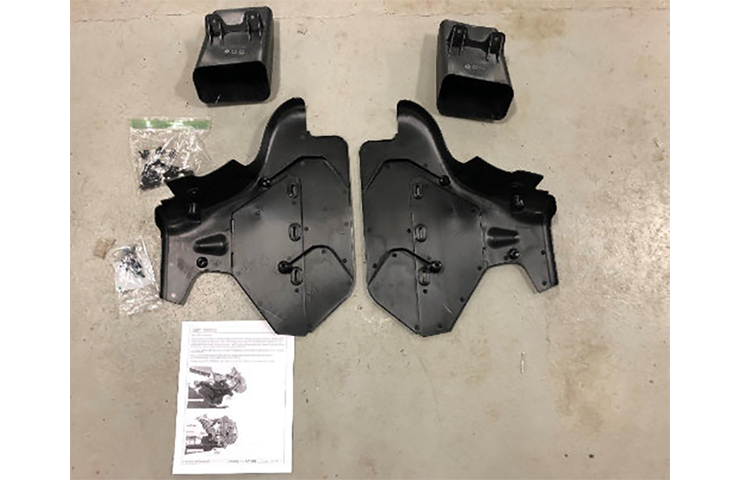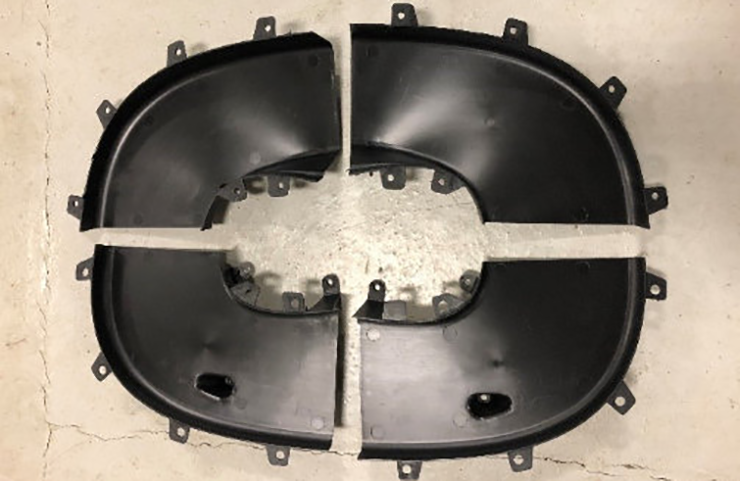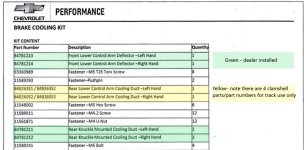Dealer should have installed those if customer wanted them on
More info for racing with Z51
Z51 Track Setup Information - Brake Burnishing, Suspension & Alignment Setting
Vehicles without Z51 package should not be used for track events and competitive driving.
High-performance features are intended for use only on closed tracks by experienced and qualified drivers and should not be used on public roads. High-speed driving, aggressive cornering, hard braking, and other high-performance driving can be dangerous.
Improper driver inputs for the conditions may result in loss of control of the vehicle, which could injure or kill you or others. Always drive safely.
Participating in track events or other competitive driving without following the instructions provided may affect the vehicle warranty. See the warranty manual before using the vehicle for racing or other competitive driving.
Be sure to follow all service procedures before driving the vehicle at track events or competitively.
Prior to each track event and again before returning to public roads, tighten the wheel nuts with a torque wrench to the proper torque specification.
Wheel nuts that are improperly or incorrectly tightened can cause the wheels to become loose or come off, resulting in a crash.
If equipped, the front license plate bracket should be removed and replaced with the aero cover for track use.
Engine Sound Management Setting
Do not place the vehicle in Engine Sound Management Stealth mode. Damage could result to exhaust valve actuators.
Engine Oil
If the vehicle is used for track events and competitive driving, the engine may use more oil than it would with normal use. Low oil levels can damage the engine.
Check the oil level often and maintain the proper level. Check the oil level often during track events and competitive driving.
Fuel
Unleaded gasoline, rated at 93 octane or higher, is required. Some high octane fuels contain additives and compounds that may damage the vehicle and void the vehicle warranty.
Dual Clutch Transmission Fluid
The transmission fluid and external filter should be changed after every 24 hours of track usage.
If prompted by the transmission fluid life monitor that remaining fluid life is low, the fluid and external filter should be changed as soon as possible.
Add an additional 2 L (2 qt) of DCT transmission fluid prior to track usage. It is not required to remove the additional 2 L (2 qt) of DCT fluid. Any transmission level set or change should be performed at your dealer.
Brake Fluid
Replace existing brake fluid with a qualified high performance brake fluid from a sealed container. Brake fluid with a dry boiling point >310 °C (590 °F) is qualified. If high performance brake fluid is used, replace it with GM approved brake fluid before driving on public roads.
If high performance brake fluid is in the vehicle and the age of the brake fluid is over a month old or unknown, replace the brake fluid before track events and competitive driving. Do not use silicone or DOT-5 brake fluids. Check the fluid level before each competitive driving event.
Brake Fade Warning Assist
The Brake Fade Warning Assist system monitors the performance of the brake system. If the system detects brake fade, or if the brake fluid is near the boiling point, the driver will be alerted.
The Brake Fade Warning Assist system is designed for use with the factory-installed brake pads or GM-approved replacement pads.
If the brake pads on the vehicle need to be replaced, use GM-approved brake pads.
If this is not done, the brake fade warning system may not function properly.
Stage 1 : The Driver Information Center (DIC) displays a “Reduce Braking to Avoid Overheating” message and brake pedal effort and travel is increased. When the message displays, the driver should decrease brake pedal pressure.
Stage 2 : The Driver Information Center (DIC) displays a “Brakes Overheated Service Now” message that the brake fluid temperature is excessive and is about to boil.
The system increases brake pedal effort and travel, and will also limit vehicle speed. The driver should immediately start a cool down lap if on the track. If this message displays, take the vehicle to be serviced at your dealer.
Brake Burnishing
New brake pads must be burnished before racing or other competitive driving.
Performing the brake burnish procedure on a base brake system can result in brake damage.
The new vehicle break-in period should be completed before performing the brake burnish procedure, otherwise damage may occur to the powertrain/engine.
Brake pedal fade will occur during any track burnish procedure and can cause brake pedal travel and force to increase. This could extend stopping distance until the brakes are fully burnished.
When this procedure is performed as instructed, it will not damage the brakes.
The brake pads will smoke and produce an odor. The braking force and pedal travel may increase. After the procedure, the brake pads may appear white at the rotor contact.
Perform this procedure only on dry pavement, in a safe manner, and in compliance with all local and state ordinances/laws regarding motor vehicle operation.
Brake Burnishing Procedure
This brake burnish procedure should only be run on vehicles with the J55 Z51 factory equipped brake system.
1. Apply the brakes 25 times starting at 100 km/h (60 mph) to 50 km/h (30 mph) while decelerating at 0.4 g. This is a medium brake application.
Drive for at least 1 km (0.6 mi) between applying the brakes. This first step may be skipped if there are more than 320 km (200 mi) on the brake pads.
2. Apply the brakes 25 times starting at 100 km/h (60 mph) to 25 km/h (15 mph) while decelerating at 0.8 g. This is a hard brake application without activating the Antilock Brake System (ABS). Drive for at least 1 km (0.6 mi) between applications.
Depending on conditions, some increase in brake pedal travel and brake pedal force may be experienced.
3. Cool down: Drive at 100 km/h (60 mph) for approximately 15 km (10 mi) without using the brakes.
4. Apply the brakes 25 times from 100 km/h (60 mph) to 50 km/h (30 mph) while decelerating at 0.4 g.
This is a medium brake application. Drive for at least 1 km (0.6 mi) between applications.
As with all high performance brake systems, some amount of brake squeal is normal.
Alternative Closed Course Brake Burnishing Procedure
This brake burnish procedure should only be run on vehicles with the J55 Z51 factory equipped brake system. This procedure should only be run on a track and only on dry pavement.
Brake pedal fade will occur during this track burnish procedure and can cause brake pedal travel and force to increase.
This could extend stopping distance until the brakes are fully burnished.
1. Start track lapping at lower speeds and lower braking efforts for three minutes of driving.
Allow for increased braking distances due to reduced brake output.
2. After Step 1, increase speed and braking effort for the next six minutes of lapping, gradually ending up at 90% effort. Continue to allow for increased braking distance due to reduced brake output.
3. Cool the brakes by lapping with minimal light braking for six minutes.
Brake Cooling Kit
Prior to any track event, high speed driving event, or competitive driving, the following should be completed: Ensure all brake cooling parts are correctly and securely installed.
Inspect for and remove any blockage in the ducts. Inspect and replace any duct that has damage.








